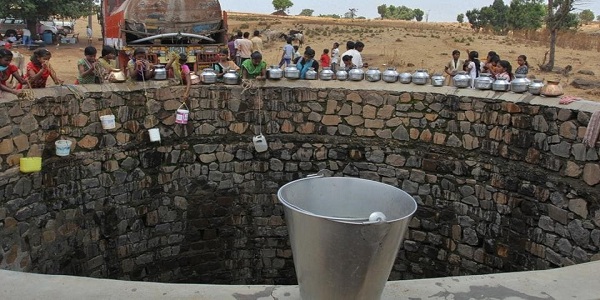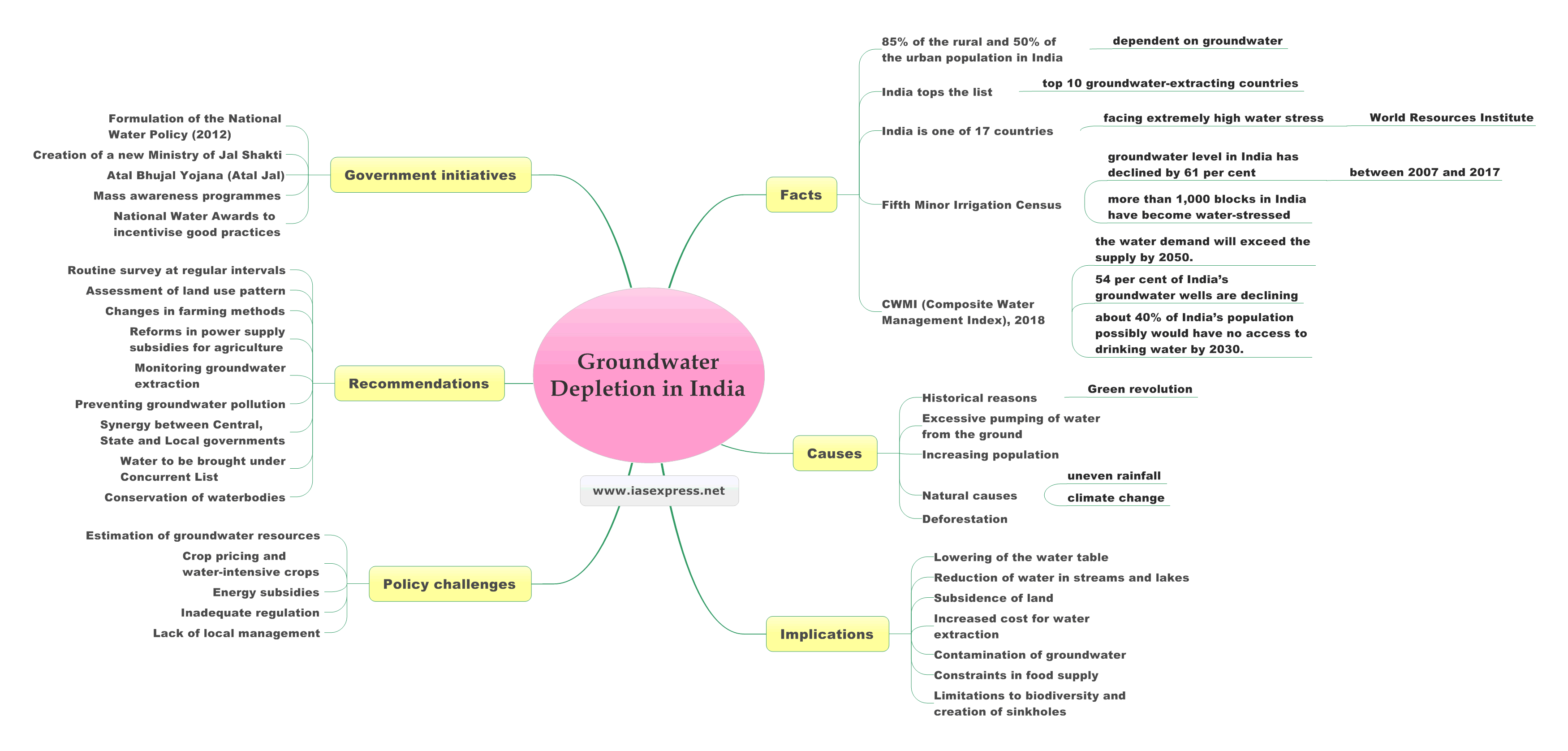Groundwater Depletion in India – Causes, Implications and Way Forward

According to new research recently carried out, millions of drinking wells around the world may soon be at risk of running dry. It further pointed out that as much as 20% of the world’s groundwater wells may be facing imminent failure, potentially depriving billions of people of freshwater. The research points out a dismal situation across the globe in the coming years. Groundwater depletion has been a concern for the past few decades. India is also not left behind. Many parts of India face acute water shortage at particular periods every year. Depleting groundwater levels have severe implications spanning from water scarcity to a gradual decline in agricultural production. Thus, the issue needs to be addressed with prompt actions to prevent India and the entire world from groundwater depletion which has grave consequences for human civilization.
This topic of “Groundwater Depletion in India – Causes, Implications and Way Forward” is important from the perspective of the UPSC IAS Examination, which falls under General Studies Portion.
Facts
- Estimates say that 85% of the rural and 50% of the urban population in India is dependent on groundwater for fulfilling their needs.
- By annually drawing 251 bcm (billion cubic meters) of groundwater, India tops the list of the top 10 groundwater-extracting countries and is the largest user of the precious liquid from the bowels of the earth.
- India is one of 17 countries facing extremely high water stress, according to a report by the World Resources Institute.
- According to the Fifth Minor Irrigation Census, the groundwater level in India has declined by 61 per cent between 2007 and 2017.
- It further observed that more than 1,000 blocks in India have become water-stressed.
- As per CWMI (Composite Water Management Index), 2018 by NITI Aayog, the water demand will exceed the supply by 2050.
- According to the Index, groundwater in India depleted at 10-25 mm per year between 2002 and 2016.
- 54 per cent of India’s groundwater wells are declining – said the report.
- It added that about 40% of India’s population possibly would have no access to drinking water by 2030.
- Recent studies suggest that groundwater levels are declining in several parts of northern India, especially in regions of high population densities.
- Studies also suggest that with the falling of groundwater levels, there has been a fall in the quality of groundwater levels in India as well.
Causes
- Historical reasons – The advent of the Green revolution during the 1960s and the use of HYV (High Yielding Variety) seeds and fertilizers led to the overuse of groundwater resources. Cheap electricity was also one of the main reasons.
- Excessive pumping of water from the ground – Pumping groundwater more frequently is a cause of groundwater shortage. Pumping groundwater at a rapid rate and not allowing it to replenish its levels is a serious cause of concern.
- Increasing population – With a rapid rise in population and its increasing demand for food, there is an expansion in the area of land under irrigation. This is leading to uncontrolled exploitation of groundwater in India.
- Natural causes – These include uneven rainfall and climate change that are hindering the process of groundwater recharge. India is mainly dependent on the Indian summer monsoon rainfall and weaker summer monsoons can cause droughts. During such dry periods, water is extracted from the ground to meet various needs leading to a reduction in groundwater levels.
- Deforestation – Plants and trees play an important role in maintaining the water table. Reckless cutting of plants and trees is adding to the problem of groundwater depletion.
Implications
- Lowering of the water table – Groundwater depletion may lower the water table leading to difficulty in extracting groundwater for usage.
- Reduction of water in streams and lakes – Groundwater and water in streams and lakes have interconnections. A substantial amount of the water flowing in rivers comes from seepage of groundwater into the streambed. Depletion of groundwater levels may reduce water flow in such streams.
- Subsidence of land – Groundwater often provides support to the soil. When this balance is altered by taking out the water, the soil collapses, compacts, and drops leading to subsidence of land.
- Increased cost for water extraction – As the depleting groundwater levels lower the water table, the user has to delve deep to extract water. This will increase his cost for water extraction.
- Contamination of groundwater – Groundwater that is deep within the ground often intermingles with saltwater that we shouldn’t drink.
- Constraints in food supply – A huge part of Indian agriculture depends on irrigation from groundwater. If groundwater availability faces difficulties then there will be hindrances in agricultural production leading to a shortage of food.
- Limitations to biodiversity and creation of sinkholes – Water table plays a major role in sustaining biodiversity. Often, sinkholes are created when the water table lowers. These sinkholes are dangerous for buildings and towers.
Policy challenges
- Estimation of groundwater resources – There is a lack of data available for estimation of groundwater sources and even if they are available, they are indicative and not representative.
- Crop pricing and water-intensive crops – The primary cause of over-exploitation has been the rising demand for groundwater from agriculture. Further, decisions such as cropping pattern and cropping intensity are taken independent of the groundwater availability in most areas. Minimum Support Price (MSP) is also available for water-intensive crops leading to widespread cultivation of such crops.
- Energy subsidies – The practice of providing power subsidies for agriculture has played a major role in the decline of water levels in India. The challenge is to find a balance between the needs of farmers and the need to ensure the sustainable use of groundwater.
- Inadequate regulation – Lack of proper regulations and their further implementation has been one of the major challenges in managing groundwater levels in India.
- Lack of local management – There is a lack of local management of groundwater resources. Local communities have an important role to play in groundwater management and there is a need for devolution of power for local management of such resources.
Recommendations
- Routine survey at regular intervals – There should be regular assessment of groundwater levels to ensure that adequate data is available for formulating policies and devising new techniques to find out a solution to the problem.
- Assessment of land use pattern – Studies should be carried out to assess land use and the proportion of agricultural land falling under overt-exploited units. This will help in determining suitable crop pattern in water-stressed areas.
- Changes in farming methods – To improve the water table in those areas where it is being overused, on-farm water management techniques and improved irrigation methods should be adopted. Methods for artificial recharge of groundwater are also welcome.
- Reforms in power supply subsidies for agriculture – The agricultural power-pricing structure needs to be revamped as the flat rate of electricity adversely affects the use of groundwater.
- Monitoring groundwater extraction – There should be a policy in place to monitor the excessive exploitation of groundwater resources to ensure long-term sustainability. Water meters could be installed to monitor overuse.
- Preventing groundwater pollution – Steps to minimize and control the dumping of industrial waste into surface water and underground aquifers should also be taken to prevent groundwater from getting polluted.
- The synergy between Central, State and Local governments – Steps need to be taken to achieve optimum benefits of groundwater conservation schemes. This can be done by ensuring coordination between all the ministries and departments of governments at the Central, State and Local levels.
- Water to be brought under Concurrent List – If water is brought under the Concurrent List of the Indian Constitution, this can help in the development of a comprehensive action plan. Consensus between the centre and states will result in better conservation, development and management of water, including groundwater.
- Conservation of waterbodies – Waterbodies maintain the groundwater level. There is a need to devise special programs for the upkeep, maintenance and restoration of water bodies with sufficient budgetary allocation.
Government initiatives
- Formulation of the National Water Policy (2012) by Department of Water Resources, River Development & Ganga Rejuvenation. The policy advocates
- Rainwater harvesting and conservation of water.
- Highlights the need for augmenting the availability of water through direct use of rainfall.
- Conservation of river, river bodies and infrastructure in a scientifically planned manner through community participation.
- Others.
- Creation of a new Ministry of Jal Shakti for dealing with all matters relating to water at one place in an integrated manner.
- The Government of India has approved Atal Bhujal Yojana (Atal Jal), a Rs. 6000 Crore Central Sector Scheme, for sustainable management of groundwater resources with community participation in water-stressed blocks of Gujarat, Haryana, Karnataka, Madhya Pradesh, Maharashtra, Rajasthan and Uttar Pradesh.
- Mass awareness programmes (Training, Seminars, Workshops, Exhibitions, Trade Fares and Painting Competitions etc.) are conducted from time to time each year under the Information, Education & Communication (IEC) Scheme of DoWR, RD & GR in various parts of the Country to promote rainwater harvesting and artificial recharge to groundwater.
- The Department of Water Resource, RD&GR has instituted National Water Awards to incentivise good practices in water conservation and groundwater recharge.
- Others.
Conclusion
Groundwater depletion is becoming an alarming issue day by day. It is high time that the causes are paid attention to and appropriate measures are taken to prevent a possible water crisis in future. With government initiatives and local community participation, groundwater depletion can be hindered. The issue needs a multisectoral approach to be dealt with.
Practise Question
- Comment on the present status of groundwater levels in India and suggest suitable measures to combat the issue of depleting groundwater levels.
- http://mowr.gov.in/sites/default/files/Steps_to_control_water_depletion_Jun2019.pdf
- https://www.prsindia.org/administrator/uploads/general/1455682937~~Overview%20of%20Ground%20Water%20in%20India.pdf
- https://india.mongabay.com/2018/06/indias-groundwater-crisis-fueled-by-intense-pumping-needs-urgent-management/
- https://www.conserve-energy-future.com/causes-effects-solutions-of-groundwater-depletion.php



Excellent..
One suggestion you should add map of india related ground water..
Thankyu